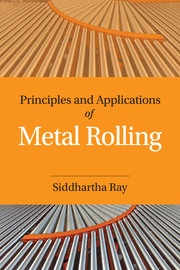1 - Introduction to Rolling Process
Published online by Cambridge University Press: 05 June 2016
Summary
Definition of Rolling Process
Rolling is the most important metal forming process. More than 95% of ferrous and non-ferrous metals and alloys are processed to their usable shapes by rolling. Usable shapes of rolled metals are plate, sheet, strip, foil, different sections like rail, beam, channel, angle, bar, rod, and seamless pipe, etc., as shown in Fig. 1.1 and Fig. 1.2.
In the rolling process, permanent deformation is achieved by subjecting the material to high compressive stress by allowing the material to pass through the gap between two rotating cylindrical rolls.
The rolls may be flat or grooved, and are kept at a fixed distance apart from each other. The rolls are rotated in opposite direction by means of electrical drive system (motor, gearbox, spindle and couplings).
Depending on the direction of rotation of the rolls, the input material enters the gap between the rolls from one end and comes out from the other end with a reduced cross-section, the roll gap area being kept less than the cross-sectional area of the input material (rolling stock). For obtaining the desired final shape of rolled material, it is generally necessary to pass the material through the rotating rolls several times. During each of the passes, the roll gap is adjusted by bringing the two rolls closer to each other, or by allowing the material to pass through different set of roll gaps with diminishing cross sectional area.
The entire assembly of the rolls mounted on bearings is held in bearing blocks (called chocks), which in turn are held between the gaps of two cast frames (called housings), complete with roll gap adjustment facilities and roll driving arrangement. The entire set up is called a rolling mill stand. One or more number of rolling stands in combination with other necessary and related equipment to obtain finished rolled products from one or similar group of input materials is called a rolling mill or rolling plant.
Rolling process can be classified based on various conditions/methods employed in rolling.
- Type
- Chapter
- Information
- Principles and Applications of Metal Rolling , pp. 1 - 29Publisher: Cambridge University PressPrint publication year: 2016



